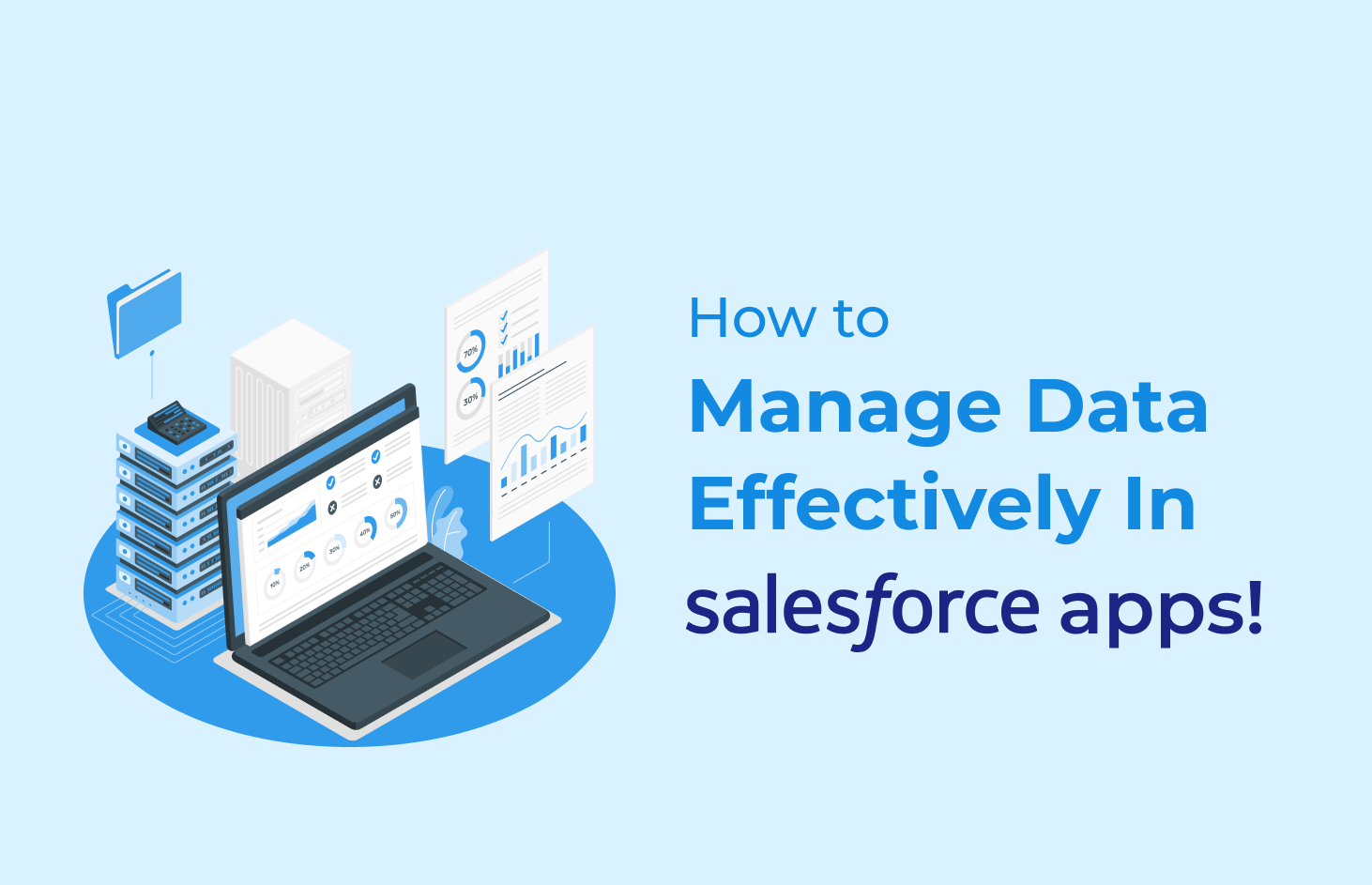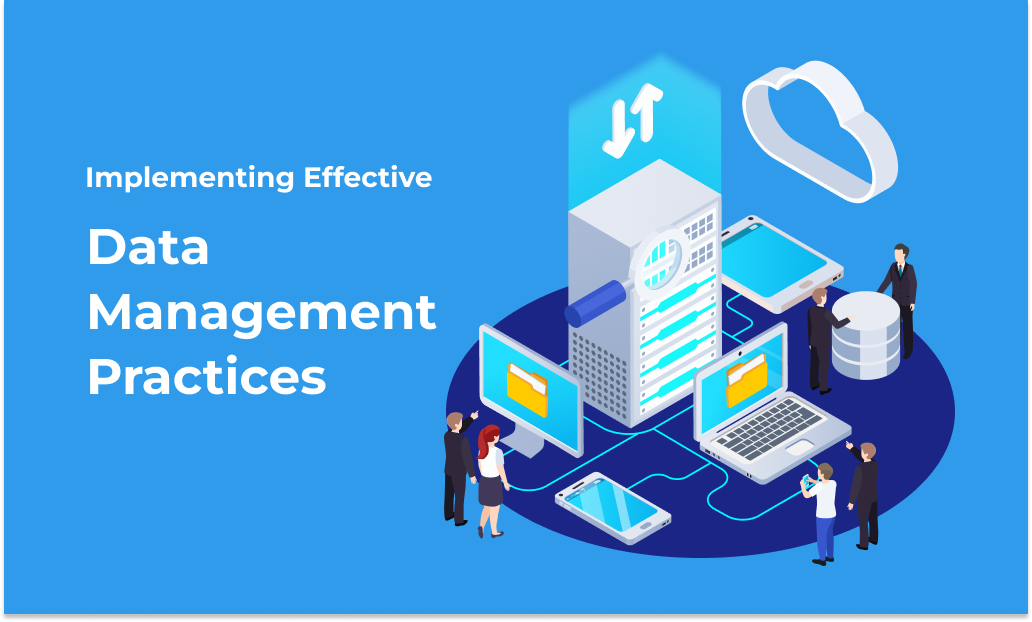How to Manage Data Effectively in Salesforce Apps
August 30, 2024

Managing data effectively in the Salesforce app is crucial for maintaining integrity, improving user experience, and making informed business decisions. Data Management in Salesforce is an effective way to manage data within the app. It consists of collecting, organizing, storing, and securing data within the platform itself. It involves processes and technologies to ensure data quality, accessibility, and security.
Let’s look at how we can manage data effectively in Salesforce.
Build a Data Management Strategy in Salesforce
A clear understanding of data and its implementation strategy will help organizations understand how to use the given data effectively. So, every organization needs a proper data management strategy for their Salesforce app to understand it, use it, align that data according to business needs, and identify specific needs.
Identify the data / Data Identification
The first step before sorting out data is knowing what you are looking for. The kind of customer data you choose to collect can affect your business decision-making. Many businesses have different sorts of data and need different data sets. Some need identity data that is unique to each other, or descriptive data that has more info about a particular lead or a business. To diminish these problems, every organization has to organize the data effectively. Good data management, especially in Salesforce Data Administration, can lead businesses to scale rapidly and help stir the whole organization to new heights. That’s why managing data effectively in the Salesforce app is a must.
So Depending on business needs one should identify the data and sort it accordingly.
Setup clear objectives
Once you’ve identified your needs, you can set a goal and objectives for your Salesforce data management strategy. Most businesses prefer a 5-year roadmap for their business data. If not managed, it impacts long-term goals and can cause a delay. For example, you want to improve customer satisfaction. However, if the data about it is not arranged or collected properly, it’s hard for businesses to understand what customers need.
To tackle this problem all you need to do is set a clear goal and collect data accordingly in Salesforce. You can use the SMART technique to set a goal. SMART: Specific, Measurable, Achievable, Relevant, and Time-Bound
Improve Data Quality
A Good quality data can give you clearer insights than poor data. Good data helps you take a better picture of your leads and can help you close the deal. This is done by data cleansing in the Salesforce app. In data cleansing, naming data properly and identifying the corrupt ones gives you a good dataset. An irrelevant and inaccurate dataset could mean dealing with duplicate records, outdated information, and incomplete datasets. Salesforce Data Handling is crucial in ensuring that the data you work with is accurate and relevant.
To remove these impurities, create a data duplicate management system in the Salesforce app where duplicate records will either be removed or merged with the original to ensure the correct data. Do regular data auditing. Auditing helps you to find errors and inconsistencies in the data and define standards for the data you collect. You can set standards in the Salesforce app. It will establish data consistency across all records.
In data validation, establish criteria to ensure that the data entered into your system meets specific standards. Using validation rules, the user can block the creation or editing of the pre-defined records that have met the criteria. It comes in handy when searching for a specific dataset within a larger dataset of Salesforce.
Establish Data Governance
Establishing a data governance framework is essential for Salesforce data management. It provides guidelines and structure for managing datasets. Defining clear roles and responsibilities is foundational to a successful data governance framework. It involves establishing clear guidelines, roles, and responsibilities for data creation, collection, storage, usage, sharing, and disposition. This defines the roles and responsibilities of the entity handling the data collection.
By implementing robust data governance, you ensure data accuracy, consistency, and security, which in turn improves decision-making, enhances operational efficiency, mitigates risks, and supports regulatory compliance. This holistic approach empowers organizations to leverage their Salesforce data effectively while maintaining its integrity and value.
Implementing Effective Data Management Practices in Salesforce

Setting up a robust data management foundation is crucial for Salesforce’s success. It involves creating clear guidelines, setting data standards, and ensuring account information is complete and accurate. After establishing naming conventions, prescribed data formats, and categorization guidelines, organizations can ensure data integrity.
Adherence to these standards can be enforced through validation rules or automated processes, guaranteeing consistent application across the user base. The integrity of Salesforce data is intrinsically linked to the quality of its constituent records.
This necessitates capturing essential information upon record creation, followed by consistent data review and updates to reflect any modifications. The timely rectification of errors or inconsistencies is equally crucial. While Salesforce CRM data management offers tools such as validation rules and duplicate management to bolster data accuracy and completeness, it is equally important to impart best practices in data entry and maintenance to all users.
Ensuring Compliance and Meeting Governance Demands
Depending on the business category the compliance rules may change. You may need to comply with specific regulatory requirements such as the General Protection Data Regulations (GDPR) or the Sarbanes-Oxley Act (SOX). These regulations will guide you on how to handle data, store data, and protect data in the Salesforce app. Salesforce allows you to manage compliance at multiple levels, from global preference to more specific use cases.
Compliances can be achieved by regular data audits, changes in management, training and educating your team and implementing robust data protection measures.
Salesforce Tools for Data Management
Salesforce has a tool for effective data management to maintain data accuracy, consistency, and security. These key tools include the Data Import Wizard and Data Loader for importing and exporting data, allowing both simple and complex data operations to be performed. Validation Rules and Duplicate Management help enforce data quality by ensuring data integrity, maintaining consistency, and preventing duplicates. Additionally, Salesforce Data Maintenance is crucial to ensure ongoing accuracy and reliability.
Salesforce integrates with third-party ETL tools like MuleSoft and Informatica for advanced Salesforce Data Integration and handling. Additionally, Process Builder and Flow automate repetitive data tasks, while Reports and Dashboards provide real-time insights into data health and Salesforce Data Optimization. Together, these tools empower businesses to manage their data efficiently, ensuring it remains reliable and actionable.
By strategically employing these Salesforce tools, organizations can establish a solid data management foundation, improve data quality, and unlock the full potential of their Salesforce investment.
Every organization needs a Salesforce Data Maintenance system for the Salesforce app to be implemented properly to use data more effectively. Data is the new oil in today’s time, and proper use will help you understand future trends, and customer needs, and improve your productivity.
Conclusion
Salesforce data management is fundamental to business success. It provides reliable, actionable data, and the ability to make a better decision for your business. It results in better customer relationships, increased productivity, and rapid business growth. Salesforce is a powerful business tool that can help companies grow if it has great data. But if Data Management in Salesforce is not handled properly, it can lead to inefficiency, bad decisions, and poor performance. This can lead to increased data management costs and missed opportunities now and in the future.
To diminish these problems, every organization has to organize the data effectively. Good Data Management in Salesforce can lead businesses to scale rapidly and help stir the whole organization to new heights. That’s why managing data effectively in the Salesforce app is a must.
Keep reading about
LEAVE A COMMENT
We really appreciate your interest in our ideas. Feel free to share anything that comes to your mind.
Our 16 years of achievements includes:
-
10M+
lines of codes
-
2400+
projects completed
-
900+
satisfied clients
-
16+
countries served




